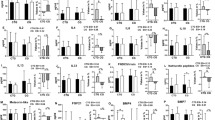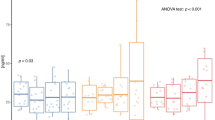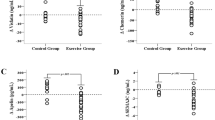Abstract
OBJECTIVE: To investigate the effect of an exercise training program on lipid profile in correlation with DHEA level and body weight and body composition in type 2 diabetic men.
DESIGN: Longitudinal, controlled clinical intervention study with exercise training consisting of an 8 week supervised program of aerobic exercise (75% VO2 peak, 45 min), twice a week and intermittent exercise, once a week, on a bicyle ergometer.
SUBJECTS: Sixteen men (age 45.4±7.2 y (mean±s.d.), HbA1c 8.15±1.7%, body mass index (BMI) 29.6±4.6 kg/m2) were randomly divided into two groups: trained group (n=8) and control group (n=8).
MEASUREMENTS: Lipid, apo- and lipoprotein and DHEA concentrations. Cross-sectional areas of subcutaneous and visceral adipose tissue and mid-thigh muscle by magnetic resonance imaging.
RESULTS: Training decreased visceral (153.25±38.55 vs 84.20±21.30 cm2, P<0.001), subcutaneous (241.55±49.55 vs 198.00±39.99 cm2, P<0.001) adipose tissue area and triglyceride levels (2.59±1.90 vs 1.79±1.08 nmol/l, P<0.05) and increased mid-thigh muscle cross-sectional area (148.30±36.10 vs 184.35±35.85 cm2, P<0.001), and DHEA levels (11.00±3.10 vs 14.25±4.10 nmol/l, P<0.05) with no modification in body weight. Changes in triglycerides were negatively correlated with changes in DHEA (r=−0.81, P=0.03). This correlation was independent of changes in abdominal fat distribution.
CONCLUSION: Training decreases abdominal fat depots, improves muscular mass and affects favourably triglyceride and DHEA levels. Changes in triglycerides and DHEA were inversely related.
This is a preview of subscription content, access via your institution
Access options
Subscribe to this journal
Receive 12 print issues and online access
$259.00 per year
only $21.58 per issue
Buy this article
- Purchase on Springer Link
- Instant access to full article PDF
Prices may be subject to local taxes which are calculated during checkout

Similar content being viewed by others

References
Barrett-Connor E . Lower endogenous androgen levels and dyslipidemia in men with non-insulin-dependent diabetes mellitus Ann Intern Med 1992 117: 807–811.
Andersson B, Marin P, Lissner L, Vermeulen A, Björntorp P . Testosterone concentrations in women and men with NIDDM Diabetes Care 1994 17: 405–411.
Fontbonne A, Eschwege E, Cambien F, Richard JL, Ducimetiere P, Thibult N, Warnet JM, Claude JR, Rosselin GE . Hypertriglyceridaemia as a risk factor of coronary heart disease mortality in subjects with impaired glucose tolerance or diabetes. Results from the 11-year follow-up of the Paris prospective study Diabetologia 1989 32: 300–304.
Laasko M, Lehto S, Penttila I, Pyorala K . Lipids and lipoproteins predicting coronary heart disease mortality and morbidity in patients with non-insulin-dependent diabetes Circulation 1993 88: 1421–1430.
Stamler J, Vaccaro O, Neaton JD, Wentworth D . Multiple risk factor intervention trial research group: diabetes, other risk factors and 12-year mortality for men screened in the multiple risk factor intervention trial Diabetes Care 1993 16: 434–444.
Howard BV . Lipoprotein metabolism in diabetes mellitus J Lipid Res 1987 28: 613–628.
Barrett-Connor E, Khaw KT . A prospective study of dehydroepiandrosterone sulfate, mortality, and cardiovascular disease New Engl J Med 1986 315: 1519–1524.
Feldman HA, Johannes CB, McKinlay JB, Longcope C . Low dehydroepiandrosterone sulfate and heart disease in middle-aged men: cross-sectional results from the Massachusetts male aging study Ann Epidemiol 1998 8: 217–228.
Shono N, Kumagai S, Higaki Y, Nishizumi M, Sasaki H . The relationships of testosterone, estradiol, dehydroepiandrosterone-sulfate and sex hormone-binding globulin to lipid and glucose metabolism in healthy men J Atheroscler Thromb 1996 3: 45–51.
Haffner SM, Mykkänen L, Valdez RA, Katz MS . Relationship of sex hormones to lipids and lipoproteins in nondiabetic men J Clin Endocrinol Metab 1993 77: 1610–1615.
Milani RV, Lavie CJ, Barbee RW, Littman AB . Lack of effect of exercise training on dehydroepiandrosterone-sulfate Am J Med Sci 1995 310: 242–246.
Yamauchi A, Takei I, Kasuga A, Kitamura Y, Ohashi N, Nakano S, Takayama S, Nakamoto S, Katsukawa F, Saruta T . Depression of dehydroepiandrosterone in Japanese diabetic men—comparison between non-insulin-dependent diabetes mellitus and impaired glucose tolerance Eur J Endocrinol 1996 135: 101–104.
Welle S, Jozefowicz R, Statt M . Failure of dehydroepiandrosterone to influence energy and protein metabolism in humans J Clin Endocrinol Metab 1990 71: 1259–1264.
Morales AJ, Nolan JJ, Nelson JC, Yen SSC . Effects of replacement dose of dehydroepiandrosterone in men and women of advancing age J Clin Endocrinol Metab 1994 78: 1360–1367.
Flynn MA, Weaver-Osterholtz D, Sharpe-Timms KL, Allen S, Krause G . Dehydroepiandrosterone replacement in aging humans J Clin Endocrinol Metab 1999 84: 1527–1533.
Nestler JE, Barlascini CO, Clore JN, Blackard WG . Dehydroepiandrosterone reduces serum low density lipoprotein levels and body fat but does not alter insulin sensitivity in normal men J Ciln Endocrinol Metab 1988 66: 57–61.
Barnard RJ, Jung T, Inkeles SB . Diet and exercise in the treatment of NIDDM. The end for early emphasis Diabetes Care 1994 17: 1469–1472.
Halle M, Berg A, Garwers U, Baumstark MW, Knisel W, Frathwohl K, König D, Keul J . Influence of 4 weeks' intervention by exercise and diet on low-density lipoprotein subfractions in obese men with type 2 diabetes Metabolism 1999 48: 641–644.
Ronnemaa T, Marniemi J, Puukka P, Kuusi T . Effects of long-term physical exercise on serum lipids, lipoproteins and lipid metabolizing enzymes in type 2 (non-insulin-dependent) diabetic patients Diabetes Care 1988 7: 79–84.
Lehmann R, Vokac A, Niedermann K, Agosti K, Spinas GA . Loss of abdominal fat and improvement of the cardiovascular risk profile by regular moderate exercise training in patients with NIDDM Diabetologia 1995 38: 1313–1319.
Honkola A, Forsen T, Eriksson J . Resistance training improves the metabolic profile in individuals with type 2 diabetes Acta Diabetol 1997 34: 245–248.
Poirier P, Catellier C, Tremblay A, Nadeau A . Role of body fat loss in the exercise-induced improvement of the plasma lipid profile in non-insulin-dependent diabetes mellitus Metabolism 1996 45: 1383–1387.
Ross R, Dagnone D, Jones PJ, Smith H, Paddags A, Hudson R, Janssen I . Reduction in obesity and related comorbid conditions after diet-induced weight loss or exercise-induced weight loss in men. A randomized, controlled trial Ann Intern Med 2000 133: 92–103.
Mourier A, Gautier JF, De Kerviler E, Bigard AX, Villette JM, Garnier JP, Duvallet A, Guezennec CY, Cathelineau G . Mobilization of visceral adipose tissue related to the improvement in insulin sensitivity in response to physical training in NIDDM Diabetes Care 1997 20: 385–391.
Astrand PO, Rythning I . A nomogram for calculation of aerobic capacity (physical fitness) from pulse rate during submaximal work J Appl Physiol 1954 7: 218–221.
Friedewald WT, Levy RI, Fredrickson DS . Estimation of the concentration of low-density lipoprotein cholesterol in plasma, without use of the preparative ultracentrifuge Clin Chem 1972 18: 499–502.
Fiet J, Gosling JP, Soliman H, Galon H, Boudou P, Aubin P, Belanger A, Villette JM, Julien R, Brerault JL, Burthier JM, Morineau G, Al Halnak A, Vexiau P . Coordinated radioimmunoassays for eight plasma steroids relevant to the investigation of hirsutism and acne in women Clin Chem 1994 40: 2296–2305.
Salomaa VV, Tuomilehto J, Jauhiainen M, Korhonen HJ, Stengard J, Uusitupa M, Pitkanen M, Penttila I . Hypertriglyceridemia in different degrees of glucose intolerance in a Finnish population-based study Diabetes Care 1992 15: 657–665.
Taskinen MR . Hyperlipidaemia in diabetes Clin Endocrinol Metab 1990 4: 743–745.
Lakka TA, Venalainen JM, Rauramaa R, Salonen R, Tuomilehto J, Salonen JT . Relation of leisure-time physical activity and cardiorespiratory fitness to the risk of acute myocardial infarction New Engl J Med 1994 330: 1549–1554.
Eriksson J, Taimela S, Eriksson K, Parviainen S, Peltonen J, Kujala U . Resistance training in the treatment of noninsulin-dependent diabetes mellitus Int J Sports Med 1997 18: 242–246.
Bernton E, Hoover D, Galloway R, Popp K . Adaptation to chronic stress in military trainees. Adrenal androgens, testosterone, glucocorticoids, IGF-1, and immune function Ann NY Acad Sci 1995 774: 217–231.
Nicklas BJ, Ryan AJ, Treuth MM, Harman SM, Blackman MR, Hurley BF, Rogers MA . Testosterone, growth hormone and IGF-1 responses to acute and chronic resistive exercise in men aged 55–70 years Int J Sports Med 1995 16: 445–450.
McIntosh MK, Berdanier CD . Differential effects of adrenalectomy and starvation–refeeding on hepatic lipogenic responses to dehydroepiandrosterone and glucocorticoid in BHE and Sprague–Dawley rats J Nutr 1988 118: 1011–1017.
Cleary MP, Seidenstat R, Tannen RH, Schwartz AG . The effects of dehydroepiandrosterone on adipose tissue cellularity in mice Proc Soc Exp Med 1982 171: 276–284.
Marin P, Oden B, Björntorp P . Assimilation and mobilization of triglucerides in subcutaneous abdominal and femoral adipose tissue in vivo in men: effects of androgens J Clin Endocrinol Metab 1995 80: 239–243.
Uusitupa MIJ, Niskanen LK, Siitonen O, Voutilainen E, Pyörälä K . Ten-year cardiovascular mortality in relation to risk factors and adnormalities in lipoprotein composition in type 2 (non-insulin-dependent) diabetic and non-diabetic subjects Diabetologia 1993 36: 1175–1184.
Author information
Authors and Affiliations
Corresponding author
Rights and permissions
About this article
Cite this article
Boudou, P., de Kerviler, E., Erlich, D. et al. Exercise training-induced triglyceride lowering negatively correlates with DHEA levels in men with type 2 diabetes. Int J Obes 25, 1108–1112 (2001). https://doi.org/10.1038/sj.ijo.0801637
Received:
Revised:
Accepted:
Published:
Issue Date:
DOI: https://doi.org/10.1038/sj.ijo.0801637
Keywords
This article is cited by
-
Subcutaneous fat loss is greater than visceral fat loss with diet and exercise, weight-loss promoting drugs and bariatric surgery: a critical review and meta-analysis
International Journal of Obesity (2017)
-
The moderating impact of lifestyle factors on sex steroids, sexual activities and aging in Asian men
Asian Journal of Andrology (2011)
-
A dose–response relation between aerobic exercise and visceral fat reduction: systematic review of clinical trials
International Journal of Obesity (2007)
-
Adipose tissue distribution and risk of metabolic disease: does thiazolidinedione-induced adipose tissue redistribution provide a clue to the answer?
Diabetologia (2007)


